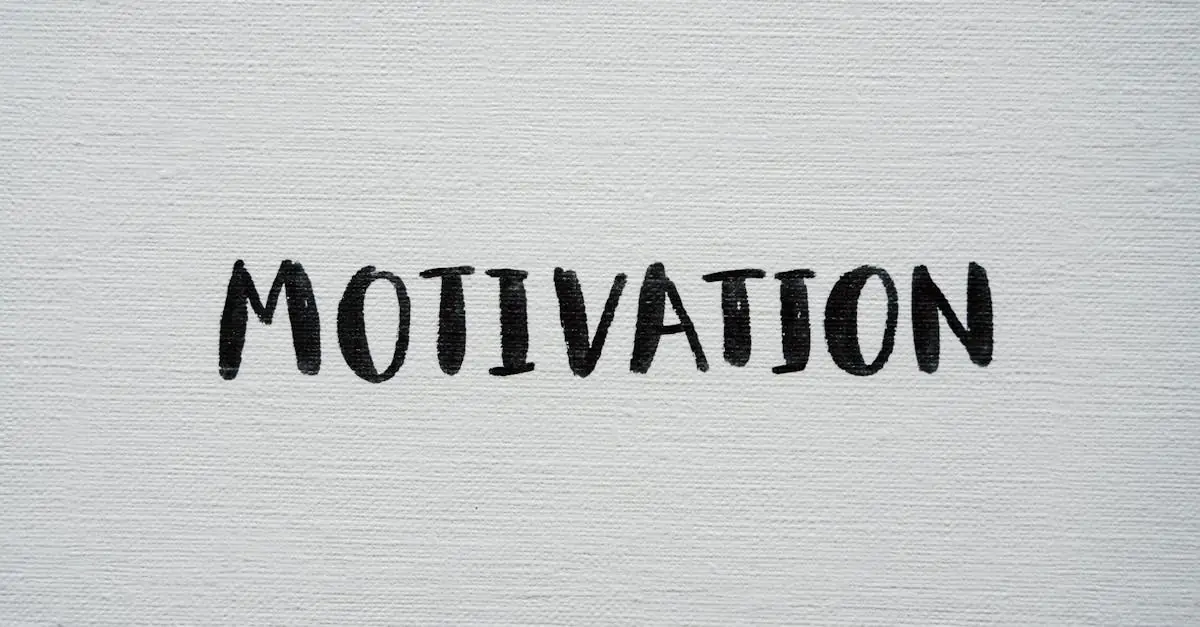Motivation is the fuel that keeps the engine of life running, but what really drives us? Enter the drive theory of motivation, a fascinating psychological concept that explains why people leap out of bed in the morning—or hit the snooze button for the fifth time. It’s all about basic needs and the internal drives that push individuals toward their goals.
Table of Contents
ToggleOverview of Drive Theory of Motivation
Drive theory of motivation explains how internal drives influence behavior. Human actions often arise from the need to satisfy basic requirements, like hunger and thirst. These fundamental drives create tension, motivating individuals to take action and restore balance.
Psychologist Clark Hull first proposed this theory in the 1940s. He suggested that all behaviors stem from biological needs. Needs, once unfulfilled, generate drives that prompt behaviors aimed at satisfying those needs.
The theory encompasses several key concepts. Primary drives refer to biological necessities, such as food and water. Secondary drives, on the other hand, relate to learned behaviors, which can include psychological or social factors, like approval or success.
An example illustrates the concept well. A student driven by the need for approval studies diligently to achieve good grades. In this case, the desire for academic success becomes a secondary drive motivated by the primary need for social acceptance.
Drive theory emphasizes homeostasis, the body’s tendency to maintain equilibrium. Disruptions in balance trigger psychological and physical responses that lead to goal-directed behavior. When individuals reach their desired state, their motivation lessens until new needs arise.
Critics of drive theory argue that it oversimplifies complex human motivations. They suggest that emotional and cognitive elements play significant roles in influencing behavior. Despite criticisms, the drive theory remains a foundational framework for understanding motivation in psychology.
Historical Background
The drive theory of motivation has its roots in foundational psychological research. This theory highlights how internal drives shape human behavior and decision-making processes.
Key Theorists
Clark Hull played a pivotal role in developing drive theory during the 1940s. His work laid the groundwork by examining how biological needs create drives. B.F. Skinner later contributed by exploring learned behaviors and reinforcement. His research shifted the focus to how external factors influence internal drives. Other theorists, such as Abraham Maslow, introduced hierarchical motivation, emphasizing the complexity of human needs. Together, these figures shaped the understanding of motivation.
Evolution of the Theory
Drive theory has evolved significantly since its inception. Researchers expanded on Hull’s ideas by incorporating cognitive elements and emotional factors. Psychological studies began to highlight the interplay between biological needs and learned behaviors. Theories such as self-determination emerged, suggesting that intrinsic motivation drives behavior beyond simple biological needs. Additionally, contemporary approaches emphasize the role of social influences and environmental context. These advancements illustrate that while drive theory provides a solid foundation, motivation encompasses a wider range of factors.
Core Concepts of Drive Theory
Drive theory revolves around the interplay between needs and internal drives. This interaction shapes human behavior, highlighting the motivations behind various actions.
Drives and Needs
Drives stem from biological needs, dictating behavior towards fulfilling those necessities. Hunger serves as a primary drive, propelling individuals to seek food. Thirst compels them towards water sources. Secondary drives emerge from interactions with the environment, such as the need for social approval. For instance, achieving milestones like academic success reflects learned behaviors, influenced by previous experiences and social contexts. Internal drives can motivate behaviors that address both biological necessities and psychological desires, illustrating their interconnectedness in shaping actions.
Homeostasis and Motivation
Homeostasis plays a vital role in maintaining balance within the body. When a biological need arises, such as hunger, it disrupts this equilibrium. The ensuing drive compels individuals to engage in goal-directed actions to restore stability. Maintaining homeostasis highlights the body’s adaptive capabilities. Examples include eating when hungry or drinking when thirsty. When internal states shift, individuals often pursue behaviors aimed at regaining balance. This drive towards equilibrium underlines the dynamic nature of motivation, showing how it integrates basic biological needs with responses to external environments.
Applications of Drive Theory
Drive theory has practical implications across various domains, including psychology, education, and workplace settings. Each application demonstrates how understanding internal drives can enhance performance and satisfaction.
In Psychology
Psychologists apply drive theory to comprehend behaviors tied to biological needs. It offers insights into how unfulfilled needs, such as hunger, affect daily actions. Therapists often use it to explore how these drives influence emotional states. Understanding these connections aids in developing effective treatment plans. For instance, a client struggling with weight loss might examine their eating habits through the lens of fulfilling emotional or social needs. This approach helps foster self-awareness and motivates clients to make healthier choices.
In Education
In educational settings, drive theory plays a crucial role in shaping learning experiences. Teachers often leverage students’ intrinsic and extrinsic motivations to enhance engagement. Recognizing that students seek approval and achievement, educators can design curricula that tap into those drives. For example, implementing goal-setting exercises can inspire students to strive for academic success. Additionally, creating a supportive environment addresses both social approval and satisfaction, driving improved academic performance. This understanding of motivation allows educators to cater to diverse learning needs and promote a more effective educational process.
In Workplace Settings
Drive theory also finds application in workplace environments, influencing employee motivation and productivity. Employers recognize that fulfilling employees’ basic psychological needs contributes to job satisfaction. Providing opportunities for professional growth and acknowledgment reinforces intrinsic drives. For example, implementing reward systems can motivate employees to attain targets and enhance productivity. Creating a culture that values employee well-being addresses their psychological needs and drives them to engage more actively. This understanding fosters stronger team dynamics and overall organizational success.
Criticisms of Drive Theory
Drive theory faces several criticisms regarding its applicability and comprehensiveness in explaining human motivation.
Limitations of the Model
The drive theory simplifies motivation by focusing primarily on biological needs. Critics highlight the model’s failure to account for complex emotional and cognitive factors influencing behavior. Determining one’s motivations often involves intricate psychological processes not fully represented in this framework. Additionally, drive theory does not adequately explain behaviors driven by external factors, such as social interactions or cultural influences. The reliance on homeostasis as the sole motivating force overlooks variations in individual experiences and responses to needs. Consequently, this model might miss the nuances of human behavior in diverse situations.
Alternative Theories
Several alternative theories offer different perspectives on motivation. Maslow’s hierarchy of needs introduces a multi-tiered framework, categorizing needs from basic physiological to complex self-actualization concerns. Self-determination theory emphasizes intrinsic motivation, highlighting the significance of autonomy, competence, and relatedness in driving behavior. Additionally, the expectancy theory asserts that individuals are motivated by expected outcomes, linking effort to perceived success. Each of these theories expands the understanding of motivation beyond the biological focus of drive theory. These alternative approaches introduce a more nuanced view of how various factors influence motivation across different contexts.
Drive theory of motivation offers valuable insights into the fundamental forces that shape human behavior. By highlighting the interplay between biological needs and learned behaviors, it provides a framework for understanding why individuals act as they do. While the theory has its limitations, particularly in addressing the complexity of emotional and cognitive influences, it remains a crucial element in the study of motivation.
In various fields like psychology, education, and the workplace, recognizing internal drives can lead to enhanced performance and satisfaction. As motivation continues to be a dynamic area of research, integrating multiple theories will help create a more comprehensive understanding of what drives human action.






